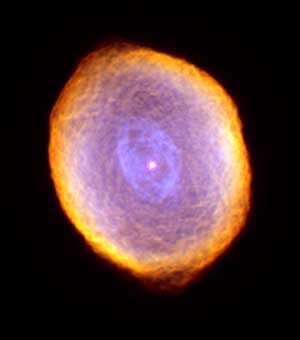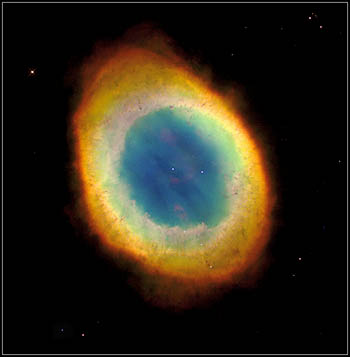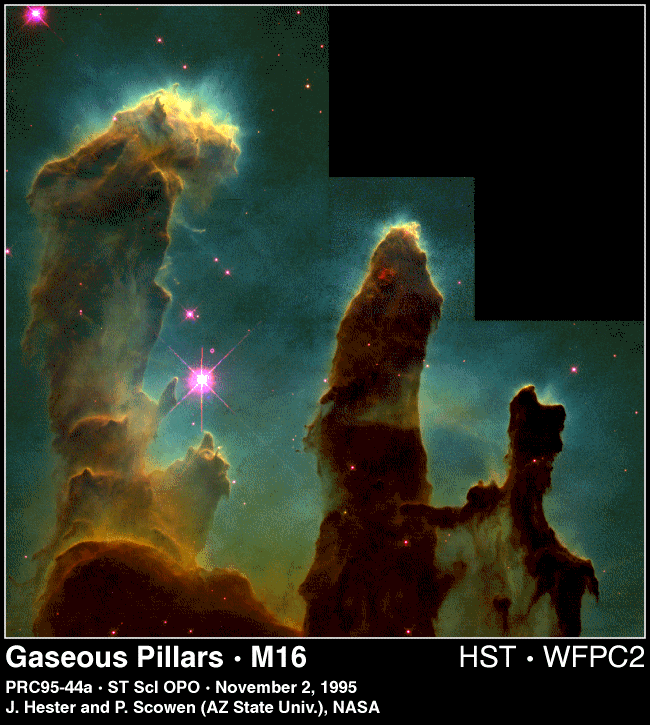Space Information
The "Spirograph" Nebula
 |
Glowing like a multi-faceted jewel, the planetary nebula IC 418 lies about 2,000 light-years from Earth in the constellation Lepus. In this picture, the Hubble telescope reveals some remarkable textures weaving through the nebula. Their origin, however, is still uncertain.
Looking Down a Barrel of Gas at a Doomed Star

The NASA Hubble Space Telescope has captured the sharpest view yet of the most famous of all planetary nebulae: the Ring Nebula (M57). In this October 1998 image, the telescope has looked down a barrel of gas cast off by a dying star thousands of years ago. This photo reveals elongated dark clumps of material embedded in the gas at the edge of the nebula; the dying central star floating in a blue haze of hot gas. The nebula is about a light-year in diameter and is located some 2,000 light-years from Earth in the direction of the constellation Lyra.
The colors are approximately true colors. The color image was assembled from three black-and-white photos taken through different color filters with the Hubble telescope's Wide Field Planetary Camera 2. Blue isolates emission from very hot helium, which is located primarily close to the hot central star. Green represents ionized oxygen, which is located farther from the star. Red shows ionized nitrogen, which is radiated from the coolest gas, located farthest from the star. The gradations of color illustrate how the gas glows because it is bathed in ultraviolet radiation from the remnant central star, whose surface temperature is a white-hot 216,000 degrees Fahrenheit (120,000 degrees Celsius).

PILLARS OF CREATION IN A STAR-FORMING REGION
(Gas Pillars in M16 - Eagle Nebula)
Undersea corral? Enchanted castles? Space serpents? These
eerie,
dark pillar-like structures are actually columns of cool interstellar
hydrogen gas and dust that are also incubators for new stars. The
pillars protrude from the interior wall of a dark molecular cloud like
stalagmites from the floor of a cavern. They are part of the "Eagle
Nebula" (also called M16 -- the 16th object in Charles Messier's 18th
century catalog of "fuzzy" objects that aren't comets), a nearby
star-forming region 7,000 light-years away in the constellation
Serpens.
The pillars are in some ways akin to buttes in the desert, where basalt
and other dense rock have protected a region from erosion, while the
surrounding landscape has been worn away over millennia. In this
celestial case, it is especially dense clouds of molecular hydrogen gas
(two atoms of hydrogen in each molecule) and dust that have survived
longer than their surroundings in the face of a flood of ultraviolet
light from hot, massive newborn stars (off the top edge of the
picture). This process is called "photoevaporation. "This
ultraviolet
light is also responsible for illuminating the convoluted surfaces of
the columns and the ghostly streamers of gas boiling away from their
surfaces, producing the dramatic visual effects that highlight the
three-dimensional nature of the clouds. The tallest pillar (left) is
about a light-year long from base to tip.
As the pillars themselves are slowly eroded away by the ultraviolet
light, small globules of even denser gas buried within the pillars are
uncovered. These globules have been dubbed "EGGs." EGGs is
an acronym
for "Evaporating Gaseous Globules," but it is also a word that
describes what these objects are. Forming inside at least some of the
EGGs are embryonic stars -- stars that abruptly stop growing when the
EGGs are uncovered and they are separated from the larger reservoir of
gas from which they were drawing mass. Eventually, the stars
themselves emerge from the EGGs as the EGGs themselves succumb to
photoevaporation.
The picture was taken on April 1, 1995 with the Hubble Space Telescope
Wide Field and Planetary Camera 2. The color image is constructed from
three separate images taken in the light of emission from different
types of atoms. Red shows emission from singly-ionized sulfur atoms.
Green shows emission from hydrogen. Blue shows light emitted by
doubly- ionized oxygen atoms.
Information from NASA educational Site, referred by Mr. RL Kirk, Space Consultant